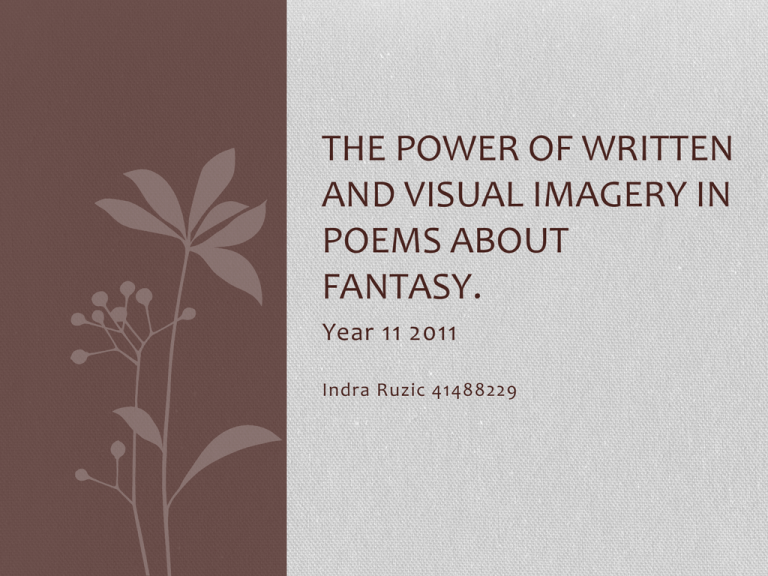Fantasy poetry - yr11poetryanthologytep424
advertisement

THE POWER OF WRITTEN AND VISUAL IMAGERY IN POEMS ABOUT FANTASY. Year 11 2011 Indra Ruzic 41488229 What is ‘imagery’? • What first comes to mind when you see the word ‘imagery’ in your textbook? Do you think of photographs? Illustrations? Perhaps you visualise your own image staring back at you from a mirror? • Imagery occurs when a written text uses language techniques to recreate events, feelings or sensations in a creative and evocative manner. Such techniques include the use of metaphor, simile, assonance, alliteration and personification, to name a few. • Poems that contain elements of the fantastic often employ descriptive language through the use of these techniques. The poets often want to tell a story that will transport readers to an earlier time period, so they will usually make references to things like Greco-Roman mythology, or Medieval literature. Imagery in Lewis Carroll’s ‘Jabberwocky’ • Lewis Carroll (Charles Lutwidge Dawson) was most famous for writing the novels ‘Alice’s Adventures in Wonderland’ and the sequel ‘Through the Looking Glass’. Both these works employ elements of the surreal and absurd, which Carroll also incorporates into his famous poem, ‘Jabberwocky’. • ‘Jabberwocky’ uses nonsense words, or as they are sometimes called, ‘neologisms’ to create images. Actions such as ‘galumphing’ aren’t what we’d call ‘real’ words. However, they do remind us of familiar adverbs such as “galloping”, which guides readers towards their meaning in the poem. • Carroll also creates fantastical creatures through his ability to play with language. What do you suppose a Bandersnatch or a Jabberwock would look like? Maybe like this? Onomatopoeia in ‘Jabberwocky’ • An interesting feature of Carroll’s poem is his use of onomatopoeic language to create visual images. Carroll places emphasis on the appearance of his words in order to create bold, visceral pictures of the creatures he is describing. • Question: • What do you think a Bandersnatch would look like? How do you imagine it would behave towards humans? Do a quick artist’s impression in your book of a Bandersnatch, and how it would appear lurking in a deep, dark forest. ‘Sir Gawain and the Green Knight’ • This poem was written by an anonymous figure termed ‘The Gawain-Poet,’ around 1390. • ‘Sir Gawain and the Green Knight’ is divided into ‘fits’, which serve the same purpose as chapters do in novels. It arranges the ballad into parts, with each ‘fit’ representing a different episode in the poem. • The most distinctive feature is the poet’s use of alliteration, which helps shape the flow of the narrative, especially when read aloud, as medieval poetry often was. • What impressions do the phrases, “The Green Knight graciously stood,” “his long and lovely locks,” and “baring the naked neck” give you of The Green Knight’s appearance and demeanour? How do you picture The Green Knight? Action and Assonance • ‘Sir Gawain and the Green Knight’ is a tale which involves elements of tension, mystery and of course, fantasy. Like ‘Jabberwocky’, alliterative words helps emphasise action in the poem: “Gawain gripped his axe and gathered it on high”. “Gripped” has vastly different connotations to the word “held”, as the former exemplifies Gawain’s fear as he gets ready to behead the Green Knight. “Held” technically has the same meaning, but is much more passive in tone. • Assonance also creates a visceral image of the action in Fit 1, particularly when coupled with alliteration in this line: “Sank deep in the sleek flesh, split it in two.” Video • Watch ‘Part One’ of this adaptation of ‘Sir Gawain and the Green Knight’ and note how the poem’s language used in the dialogue. Is it alliterative or not? How do you compare this visual representation with your own impressions of the story and characters? • http://www.youtube.com/watch?v=t855W1rFYEo References • ‘Sir Gawain and the Green Knight’. Anonymous. Translated by J. A. Burrow. London: Penguin Books • ‘Jabberwocky’. Lewis Carroll. ‘Poems of the Fantastic and Macabre’. http://poemsofthefantastic.com/











